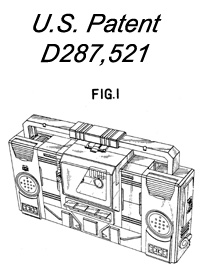When Hasbro looked to produce the second series of G1 in 1985, a number of molds from Takara’s defunct robot toylines were available to them, and found their way into Transformers usage. One of the last designs pressed into Hasbro’s service was Blaster, a boombox style portable radio and cassette player.
Origins
Blaster was originally designed for Takara’s Microman: Microchange line. He was released in this capacity in 1984 as MC-21 Radio-Cassette Robo, in two colors schemes: dark blue and light blue, or red and dark blue. This version of the toy was considerably different than the Transformers release, in that it featured a working AM radio. The right robot leg had a battery door for two AA batteries at its rear, and the left leg featured a jack for the included monophone earbud. The center of the back featured compartment to store a single Microcassette Robo. The front cassette door featured a male jack for the included AM radio unit, itself disguised as a Microcassette, that had to be inserted in order to receive radio signals. An on/off switch and volume knob also adorned the Radio-Cassette Robo. The headphone could be stored in robot mode by plugging it through the gun’s large aperture, winding the cord around the narrow stock, and pegging the male jack through the hole in the upper part of the shoulder stock. Blaster was designed by Hiroyuki Obara. The US Patent, titled Reconfigurable radio cassette recorder toy (aka Transformers G1 Blaster) was filed on May 30, 1984 (U.S. Patent No. USD287521 S).
Description
>Blaster was heavily retooled and somewhat redecorated for his Transformers debut. The entire electronic portion of the toy was removed, with switches, hatches, and ports sealed up and molded over. His red and silver body was highlighted with a bright yellow tape door, as opposed to the stickered blue door of the original. The cassette door could now hold a Mini-Cassette Transformer, although no Autobot cassettes would be released until the following year. Blaster’s former headphone jack, power switch, and volume knob all became molded details. He features a working eject button, as well as a play and stop button. The play button simply locks in the down position until the stop or eject buttons are pushed, releasing it. Blaster has a fairly simple transformation and blocky robot mode, both necessitated by the original design needing room for the electronic equipment. His robot mode is adorned by a couple of stickers. He still features the long, spindly scoped rifle included with the Microchange release.
Collector Notes
Despite his bulky appearance, Blaster joins all his brethren in having design weaknesses. The most well-noted problem is that his buttons tend to jam over time. The buttons are orchestrated by a Byzantine system of sliding wedges, and the friction between all the parts forcing against each other makes use of the button functions of even an unworn Blaster difficult. The solution is typically to disassemble the whole assembly and clean, polish, and possibly lubricate the apparatus. A related problem is the tape door’s catch being snapped by prying the door open when the buttons don’t open it. If the buttons don’t function, it is best to disassemble Blaster to free the door. Blaster’s rifle is notoriously long and thin, and frequently found with a broken scope mount, stock, barrel, or some combination of the above.
Variants
The most notable variation on Blaster’s production is the presence of a vestigal back hatch on earlier releases. Though nonfunctional, the cover for Microchange Radio-Cassette’s rear storage compartment is a separate piece. Later, the mold was modified to make the entire back panel a single smooth molded piece. Minor variations also occurred with the various molded details of Blaster’s gun.
Availability
Blaster was available in 1985, and again in 1986. He was reissued in 2006 as part of Takara’s Transformers Collection in Japan. He was released in the US in 2010 as part of Universe 2. This version featured a slightly different shade of silver plastic, with a hint of brown or sandy color.
Redecos & Retools
>Blaster’s mold was originally used to make MC21 Radio-Cassette in two versions: blue and red. The mold was redecoed and slightly retooled in Japan in 1987 as Twincast, part of The Headmasters. This version was reissued in 2006’s Collector’s Edition in Japan with slightly different stickers. Broadblast was slightly redecoed and retooled again for a 2012 reissue in Encore.

















